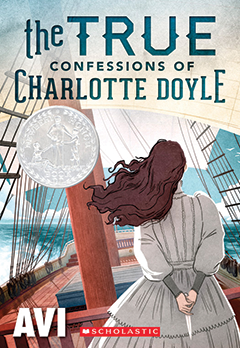This summer and early fall, I’m re-posting the 10 Most-Read Stories Behind the Stories from this blog. I’ve rewritten each essay somewhat and included the most-often-asked question about the book.
We’ve come to #1. Does it surprise you that the most-read of my story behind the story is The True Confessions of Charlotte Doyle? It was my 22nd book and a Newbery Honor winner in 1991.
__________________________________
 I began the last story about a story by telling how book A (Something Upstairs) led to book B (The Man Who Was Poe). Here is the story how the Poe book led to Book C, The True Confessions of Charlotte Doyle.
I began the last story about a story by telling how book A (Something Upstairs) led to book B (The Man Who Was Poe). Here is the story how the Poe book led to Book C, The True Confessions of Charlotte Doyle.
Poe is generally credited with having invented the detective tale with his short story, Murders in the Rue Morgue. (1841) That story, profoundly influential, also came to be known as a “Locked Room Mystery.” Which is to say something happens in a room that is presumably inaccessible.
Well, I thought, living as I was on the edge of the Atlantic Ocean, what could be more of a “Locked Room” than a sailing ship at sea?
If you turn to page 129 of The Man Who Was Poe, you will find these words by a character named Captain Elias:
“Now, Master Edmund, if you’ve time to hear a good yarn, I’ve one for you. You see, The Lady Liberty had a sister ship. Seahawk, her name was—”
When I wrote those words, it was the beginning of my thinking of The True Confessions of Charlotte Doyle: I would write a “locked room” mystery set on a 19th Century sailing ship. I even signed the contract to write a book which, for the moment, was called The Seahawk.
But I didn’t begin the book. The first problem was that for about eight months, I moved to Venice, Italy. My wife had a sabbatical; and a former editor of mine offered a Venetian apartment. I could not resist.
Indeed Venice was a fabulous experience.
However, I had not reckoned on two things. Being surrounded by the Italian language (or the Venetian version of it) meant that I was, to my great surprise, radically hampered in my writing. It crimped my rhythms, made my English excessively formal and ornate, and stunted my vocabulary. Also, this being in the early days of portable computers, my access to a printer was once a week. A key part of my writing process was missing.
I stopped writing the book. All I could do was think about it.
Only when I returned to Providence did I resume writing and by then the book had become The True Confessions of Charlotte Doyle. It also began as a mystery, and while it has elements of that, it traveled on to become something rather different.
The book was done (I thought) when editor Richard Jackson called. “I’ve been thinking,” he said. “We missed something. When Charlotte leaves the boat after the voyage, she doesn’t say goodbye to the crew. That’s out of character.”
Which is to say, since I had written the ending, I knew she would return to the ship. But at the narrative moment, she did not. Only then did I write that farewell scene on page 199. When the character Ewing says, “You’re my mermaid now,” I had tears in my eyes because like so many readers, I too had fallen in love with Charlotte „, but it was time for me to say “bon voyage.”
But wait! That was not the end of The Seahawk. She reappears in another book! Beyond the Western Sea.
__________________________________
 Most often asked question:
Most often asked question:
Will I write a sequel? The short answer is, no. My reason: Countless readers have told me how important Charlotte has been to them. The importance has to do with Charlotte’s growth and move toward independence. If I said what Charlotte did with her life, I think it would diminish her release to an open world. I’d rather let every reader choose what Charlotte does, even as I hope they will choose what they do with their lives.